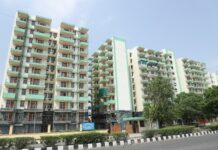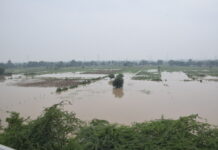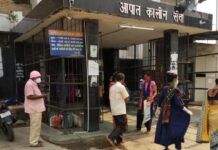[vc_row][vc_column][vc_column_text]
Not very far away from the National Capital, a green war of sorts is being fought between those who want to protect the rich biodiversity of the Aravallis hills and those who think exploiting the ranges in the name of development is okay.
Mining, both legal and illegal, had been a bane of the Aravallis range spread across parts of Delhi, Haryana, Rajasthan and Gujarat for long. Concerned over the problem of illegal mining destroying the ecology of the hills, the Supreme Court had, in 2009, imposed a complete ban on quarrying in the area.
Earlier, the top court had banned mining within 5-km radius of Delhi but the ban could not stop the illegal operators from continuing to degrade the ranges.
As several civil society groups came forward to save the hills and a number of cases against the mindless exploitation of the Aravallis piled up in courts, a tug of war between the green vigilantes and the violators has begun.
The issue came into focus recently after environmental activists launched an online campaign urging the Supreme Court not to entertain a petition from the Haryana government which had urged the apex court to allow mining in the Aravalli ranges as it would help the administration generate jobs.
The state had planned around 10 mining blocks on 600 hectares of land, most of which was part of the newly discovered wildlife corridors. A similar proposal was made to the activists who disapproved of it.
The activists cited the ecologically fragile nature of the hill range, which falls in Gurugram and Faridabad districts of Haryana, and have argued that illegal mining not only depletes groundwater levels, it also adds to air pollution, which has become a regular problem affecting the NCR area.
In its plea, the Haryana government cited the example of Rajasthan, which has allowed mining with legal safeguards and assured the court that it too would take all steps required to protect the environment in the region.
In 2018, the Central Empowered Committee (CEC), appointed by the apex court, had pointed out that 31 of the 128 Aravallis hillocks in Rajasthan had vanished over the past five decades due to illegal mining. The panel had sampled the hillocks from among the 2,269 hillocks in the state.
Following the report, the Supreme Court had asked Rajasthan to stop mining but the state later allowed quarrying with proper guidelines. The activists argue that the state governments are guided by commercial interests when it comes to dealing with the Aravallis. That may be true given that Rajasthan receives around Rs 5000 crore per year as royalty from mining operations.
Haryana too got revenues worth over Rs 1000 crore from mining in 2020-21 but also has dues pending from such operations to the tune of over Rs 1700 crore. The state revenue from mining registered a 31 percent jump over the past year despite the lockdown in 2020. The same was Rs 702 crore in 2019-20 and Rs 583 crore in 2018-19.
As there are no minerals in the state, Haryana usually mines for stones which are used for construction purpose.
Earlier in February 2019, Haryana had passed the Punjab Land Preservation (Haryana Amendment) Bill, which changed the Punjab Land Preservation Act, 1900. The PLPA aimed at conserving ground water and empowered the state to control activities like breaking up of land. This law protected the notified green areas in the past.
In effect, the move of the Haryana government was meant to take the protective cover off the Aravallis and the Shivaliks, exposing around 28,000 hectares of forest land to private builders and land sharks.
A miffed Supreme Court ordered the state to stop implementation of the Bill that sought to open up 33 percent of forest area for development and mining, an important source of revenue for the state.
Sensing an opportunity, the Opposition Congress had alleged a Rs 50,000-crore scam through PLPA amendment and said the state government had played into the hands of some builders and politicians who were eyeing to corner huge gains.
The ML Khattar government’s appeal had reached the apex court after the CEC suggested that the state could allot mines in around 1500 hectares in Gurugram and Nuh and 600 hectares in Faridabad. The administration had simultaneously started surveying the area.
Interestingly, the Jannayak Janata Party, which shares power in Haryana along with BJP, had included protection of Aravallis in its agenda.
The issue is that while existing laws are sufficient to curb the menace of illegal mining, the problem continues due to the unholy nexus between the officials and the violators.
Whenever activists raise a hue and cry and the matter reaches the top court, a wrong doing is halted, but in several other instances the violations go unchecked and result in denuding of land by tree felling and flattening of the hillocks.
Encroachments are another big problem which choke the hill ranges. Pointing at the positives of the Aravallis, the activists say they act as lungs of the NCR region and must be protected.
Besides, the hill ranges facilitate ground water absorption and help add to the water table which is depleting due to rapid urbanization in the areas bordering Delhi.
Further, the ranges also support a variety of flora and fauna and wildlife, which needs to be protected, the activists point out.
Justifying the Haryana government plea to the top court to allow mining, the activists contend that quarrying operations should be held in isolated areas where the forests have already degraded and where the chances of regeneration of green cover are bleak rather than the Aravallis which are rich in biodiversity.
The activists have been able to clean and reforest some areas and regenerate some water bodies in the hill ranges. But a larger sustained effort is needed while discouraging influential lobbies from violating the rules to secure whatever is left of the Aravallis.
[/vc_column_text][/vc_column][/vc_row]
Disclaimer: We do undertake rigorous checks on content provided by contributors before publishing the same. If you come across some factual errors, kindly bring this into our notice and we shall review your objection and claim as per our policy and display correction credits and corrections on the article itself.
The opinion expressed in the article is of the writer. Writer is a freelance journalist/journalist based in Delhi





























